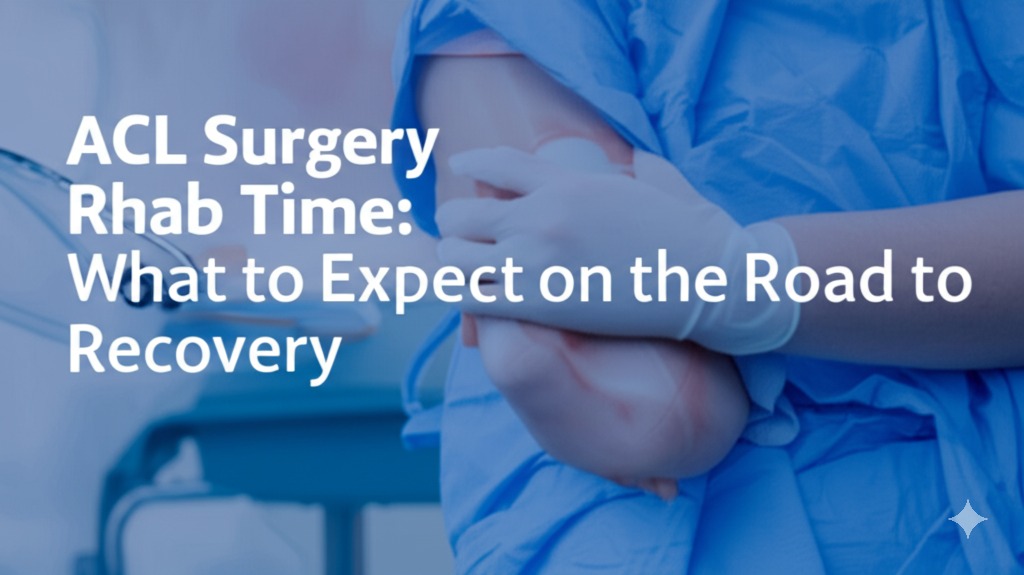Tearing your ACL (anterior cruciate ligament) can be a major setback—especially for athletes and active individuals. But the good news? With modern surgical techniques and dedicated rehabilitation, a full recovery is very achievable. Understanding the ACL surgery rehab time is crucial for setting realistic expectations and staying motivated throughout the healing process.
In this article, we’ll break down the typical recovery timeline, what each phase of rehab involves, and tips to speed up your return to activity—safely and successfully.
Understanding ACL Surgery Recovery
ACL surgery, often involving reconstruction using a graft, is just the beginning of a structured recovery journey. The rehabilitation timeline can vary depending on several factors, including:
- The severity of the injury
- The type of graft used
- Your age and fitness level
- Adherence to your rehab program
On average, ACL surgery rehab time ranges from 6 to 12 months, but returning to full sports activity may take longer for some individuals.
The Phases of ACL Surgery Rehabilitation
Phase 1: Immediate Post-Surgery (Week 1–2)
Goals:
- Reduce swelling and pain
- Protect the surgical site
- Regain basic knee mobility
During this phase, expect:
- Use of crutches and a knee brace
- Gentle range-of-motion exercises
- Icing and elevation to control inflammation
Tip: Start physical therapy as soon as your doctor approves. Early movement helps prevent stiffness and improves long-term outcomes.
Phase 2: Early Recovery (Weeks 2–6)
Goals:
- Restore full knee extension
- Increase flexion gradually
- Begin strengthening exercises
Your rehab will focus on:
- Walking without crutches
- Straight-leg raises and quad sets
- Stationary biking (as tolerated)
Key milestone: By week 6, most patients can walk unaided and have improved strength and mobility.
Phase 3: Intermediate Rehab (Weeks 6–12)
Goals:
- Improve muscle control and stability
- Increase activity tolerance
- Build strength around the knee
Exercises may include:
- Squats and lunges (within limits)
- Balance training
- Step-ups and leg presses
At this stage, consistency is everything. Follow your therapist’s plan closely to avoid setbacks.
Phase 4: Advanced Rehab (Months 3–6)
Goals:
- Regain full strength and coordination
- Prepare for return to sports or higher activity levels
Key components:
- Sport-specific drills (non-contact)
- Agility and plyometric training
- Continued flexibility work
Caution: While you might feel strong, your graft is still healing. Avoid rushing back to competitive sports too soon.
Phase 5: Return to Sport (6–12 Months)
Goals:
- Full recovery of strength and function
- Confidence in knee performance
- Safe return to sport or activity
You’ll undergo tests to assess:
- Range of motion
- Muscle symmetry
- Functional movements like jumping, cutting, and pivoting
Pro tip: Always get clearance from your surgeon or physical therapist before resuming full athletic activity.
Factors That Influence ACL Rehab Time
No two recoveries are the same. Several factors can speed up or slow down your progress:
- Pre-surgery fitness: Stronger muscles help you recover faster.
- Type of graft used: Patellar tendon, hamstring, or cadaver grafts may impact healing time.
- Commitment to rehab: Skipping sessions can delay recovery.
- Presence of other injuries: Damage to meniscus or cartilage may lengthen the timeline.
Tips for a Successful ACL Rehab Journey
- Stay consistent with physical therapy appointments and home exercises.
- Communicate openly with your care team about pain, setbacks, or concerns.
- Fuel your recovery with a balanced diet rich in protein, vitamins, and hydration.
- Prioritize rest and sleep to support tissue healing.
- Keep a positive mindset. Set small goals and celebrate milestones.
When Can You Return to Sports After ACL Surgery?
Most athletes can return to non-contact sports around the 6-month mark, but cutting and pivoting sports like soccer or basketball often require 9–12 months of rehab.
Returning too early can increase the risk of re-tearing the ACL or injuring the other knee. Be patient—your long-term health is worth the wait.
Conclusion: Be Patient, Be Persistent
Recovering from ACL surgery is a marathon, not a sprint. While the average ACL surgery rehab time falls between 6 to 12 months, the journey is highly individual. Trust the process, lean on your rehab team, and stay focused on your goals.

Kallie Snyder is an author at Stonegate Health Rehab, providing valuable insights, recovery guidance, and rehab resources to help individuals achieve better health and well-being.
